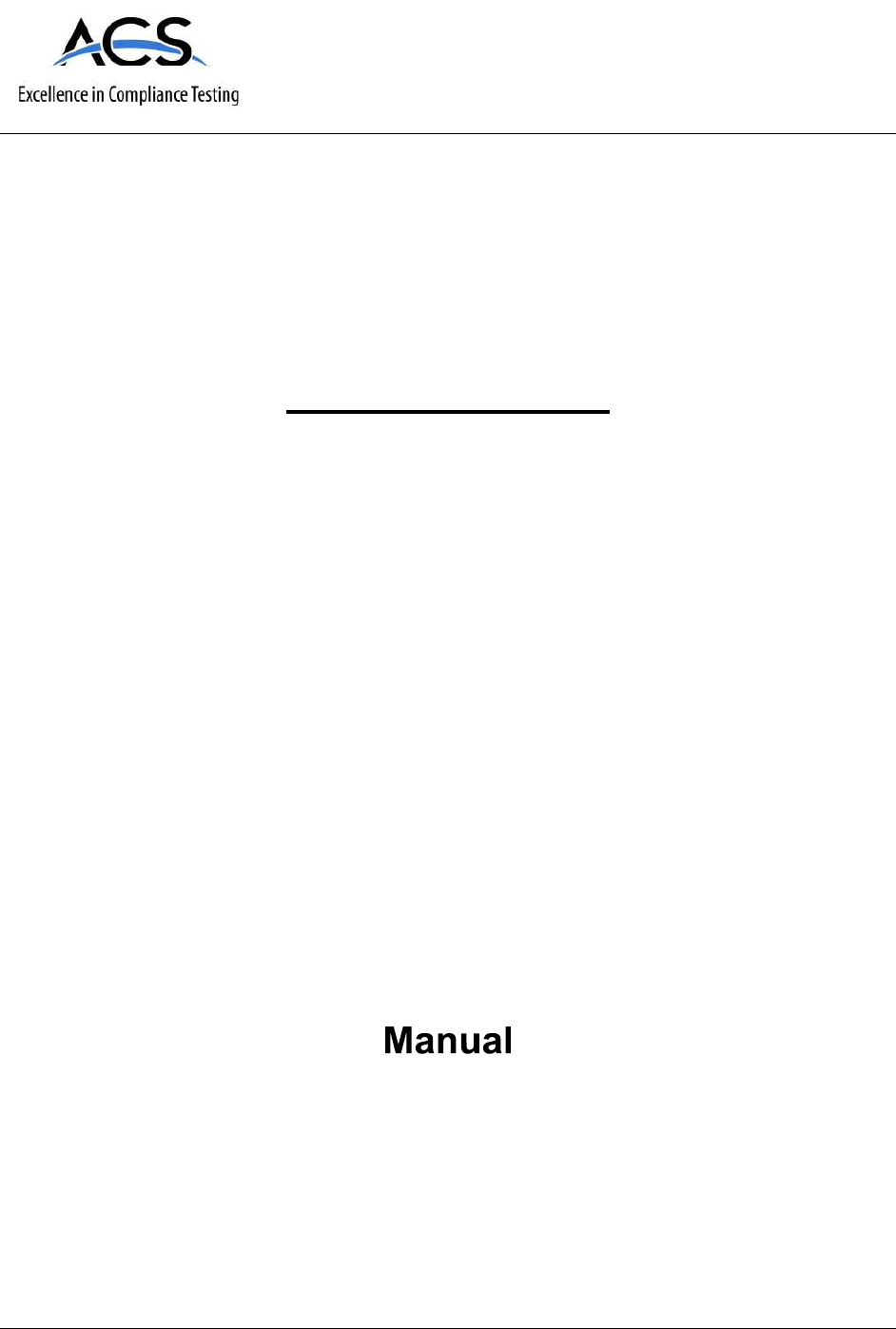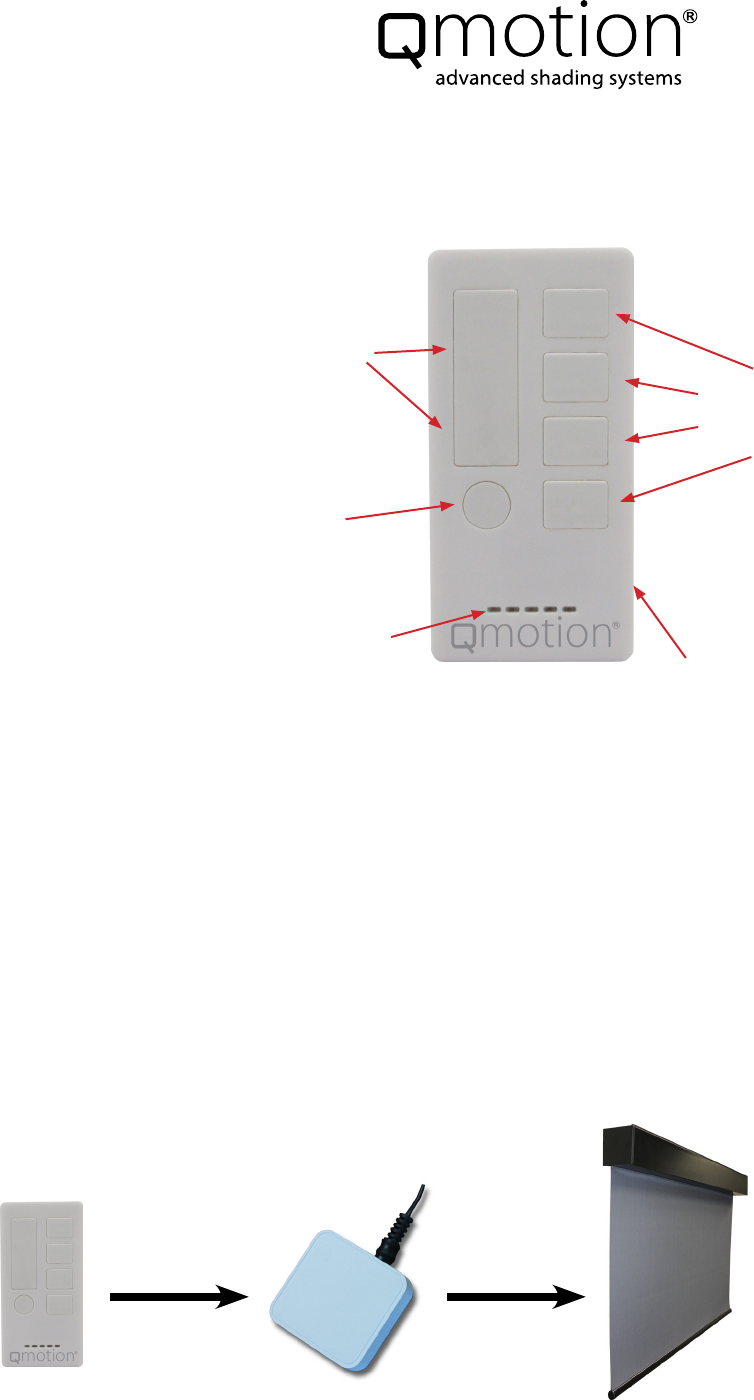The Watt Stopper d b a Qmotion 240Z Zigbee Roller Shade User Manual 15 0213 Exhibit Cover
Qmotion Incorporated Zigbee Roller Shade 15 0213 Exhibit Cover
Manual

5015 B.U. Bowman Drive Buford, GA 30518 USA Voice: 770-831-8048 Fax: 770-831-8598
Certification Exhibit
FCC ID: 2ABLX-240Z
IC: 8832A-240Z
FCC Rule Part: 15.247
IC Radio Standards Specification: RSS-247
ACS Project Number: 15-0213
Manufacturer: QMotion Incorporated
Model: QMRS-240Z

Step 1
Open the coordinator hub for joining or pairing the
remote and the shade.
- If you already have a coordinator/
router check manufacturers instruction on
how to place into pairing mode
- If using QMotion coordinator/router push
pairing button on side and let go
Step 2
Slightly tug the shade 6” to wake shade up. The
shade will try to join the network by moving up and
down (jogging). Will be in learn mode for 2 minutes.
Step 3
Press any button on the remote to join the network.
Step 4
Shade is now connected to network. LED on
remote will ash letting you know if connected.
Step 5
Learn shade to remote. Hit “MODE SELECT”
button on the back of remote. Then you will hit “UP”
button. Shade will then move to 75% position.
Step 6
Tug the shade 6” and let go. Shade is now learned
to the remote.
Step 7
To learn bottom limit, hold “DOWN” button for ve
seconds. Shade will jog.
Step 8
Tug shade to enter learn mode.
Step 9
Pull shade to desired bottom limit.
Step 10
Hold “DOWN” button for ve seconds to store posi-
tion. Shade will jog to conrm learned bottom limit.
Step 11
Hit “DOWN” button to conrm bottom limit.
Step 12
Hit “UP” button to open shade. Shade will travel to
full open position. You now have bottom limit and
intermediate positions learned.
NETWORK SETUP AND
INSTALLATION INSTRUCTIONS
UNIVERSAL REMOTE (MODEL #QZR-ZIG2400)
& CRYSTAL CONNECT (MODEL #QMRS-240Z)
Channel Button
Variable
Position
Butttons
Channel/Mode
Reverse Side
Mode Select Button
Pairing the remote
to the coordinator/
router allows for
communications
to your shades Universal
Remote Router / Coordinator Crystal Connect
Roller Shade
Up/Down
Buttons
IMPORTANT
Read and understand all instructions before installing.
Always wear personal protection equipment including
safety glasses and gloves. Use a ladder per its
manufacturer’s instructions. Work safely!

FCC
Warning: Changes or modications to this device not expressly approved by QMotion Advanced
Shading Systems could void the user’s authority to operate the equipment.
NOTE: This equipment has been tested and found to comply with the limits for a Class B digital de-
vice, pursuant to Part 15 of the FCC Rules. These limits are designed to provide reasonable protec-
tion against harmful interference in a residential installation. This equipment generates, uses, and
can radiate radio frequency energy and, if not installed and used in accordance with the instructions,
may cause harmful interference to radio communications. However, there is no guarantee that inter-
ference will not occur in a particular installation. If this equipment does cause harmful interference to
radio or television reception, which can be determined by turning the equipment off and on, the user
is encouraged to try to correct the interference by one or more of the following measures:
• Reorient or relocate the receiving antenna.
• Increase the separation between the equipment and receiver.
• Connect the equipment into an outlet on a circuit different from that to which the receiver is con-
nected.
• Consult the dealer or an experienced radio/TV technician for help.
This equipment complies with FCC radiation exposure limits set forth for an uncontrolled environ-
ment. This equipment should be installed and operated with minimum distance 20cm between the
radiator and your body. This transmitter must not be co-located or operating in conjunction with any
other antenna or transmitter.
INDUSTRY CANADA
Under Industry Canada regulations, this radio transmitter may only operate using an antenna of a
type and maximum (or lesser) gain approved for the transmitter by Industry Canada. To reduce po-
tential radio interference to other users, the antenna type and its gain should be so chosen that the
equivalent isotropically radiated power (e.i.r.p.) is not more than that necessary for successful com-
munication.
Conformément à la réglementation d’Industrie Canada, le présent émetteur radio peut fonctionner
avec une antenne d’un type et d’un gain maximal (ou inférieur) approuvé pour l’émetteur par Indus-
trie Canada. Dans le but de réduire les risques de brouillage radioélectrique à l’intention des autres
utilisateurs, il faut choisir le type d’antenne et son gain de sorte que la puissance isotrope rayonnée
équivalente (p.i.r.e.) ne dépasse pas l’intensité nécessaire à l’établissement d’une communication
satisfaisante.
This device complies with Industry Canada licence-exempt RSS standard(s). Operation is subject
to the following two conditions: (1) this device may not cause interference, and (2) this device must
accept any interference, including interference that may cause undesired operation of the device.
Le présent appareil est conforme aux CNR d’Industrie Canada applicables aux appareils radio
exempts de licence. L’exploitation est autorisée aux deux conditions suivantes: (1) l’appareil ne doit
pas produire de brouillage, et (2) l’utilisateur de l’appareil doit accepter tout brouillage radioélectrique
subi, même si le brouillage est susceptible d’en compromettre le fonctionnement.